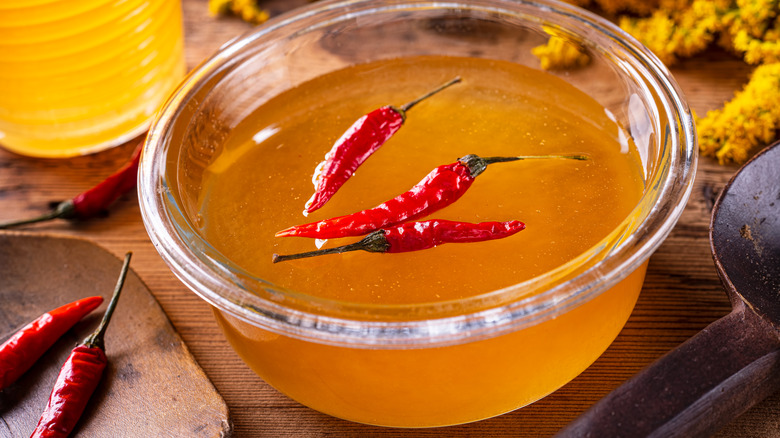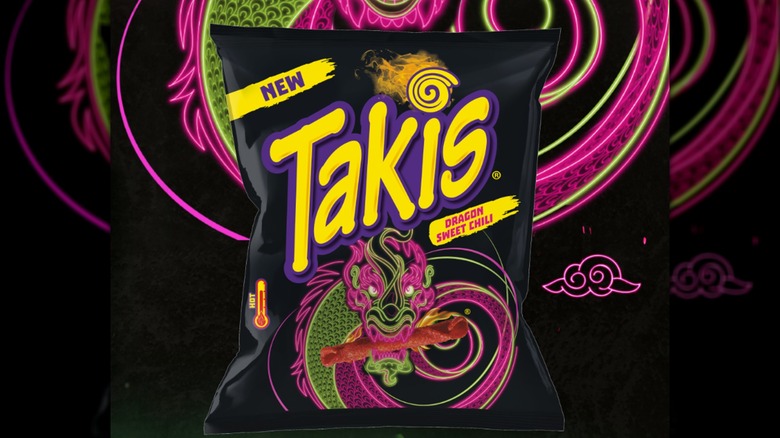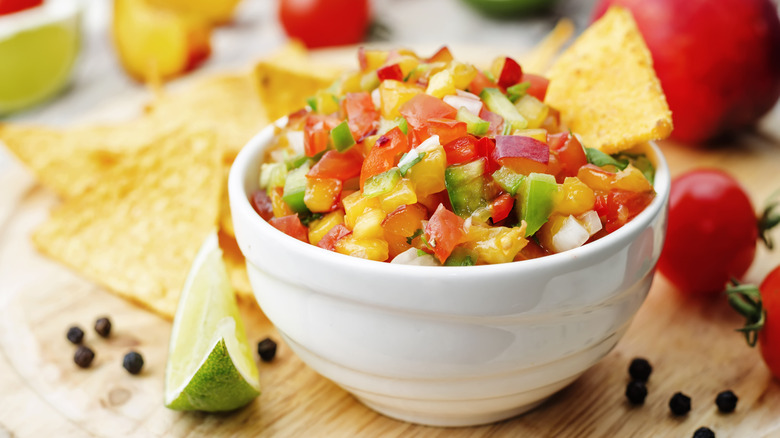What Are 'Swicy' Foods And How Did They Become So Popular?
After enough utility sandwiches violently scarfed on a 30-minute lunch break, it can be easy to forget that food is an art and eating is a sensory experience. Enter "swicy" — the perhaps-unlikely gastronomic superstar here to remind foodies why they're passionate about food in the first place.
Swicy (a portmanteau of sweet and spicy) is the hottest flavor trend (pun intended) since foodies first found out about umami. Maybe you've tried peach salsa or hot pepper jelly. Maybe you've even sprinkled some Tajín on slices of fresh fruit. Either way, swicy has been a "thing" for a long time, and there's a good chance that you've already been riding the swice train without even realizing it. Korean gochujang is swicy, and so are many Vietnamese and Indian dishes. Thai chili sauce? Swicy. It's even an ancient flavor combo, as demonstrated by xocoatl, the Aztecs' pepper-spiked hot chocolate.
The New York Times named swicy as a food trend to watch out for in 2022, and now, the National Restaurant Association has named swicy as a top food trend. According to research firm Datassential, sweet-spicy offerings have cropped up on menus 38% more over the past year. The evidence is undeniable: Swicy has entered the building in the year of our lord 2023.
Sweet heat on the street
The chili-pepper-infused phenomenon Mike's Hot Honey has been taking the world (especially NYC) by storm over the past year. Paulie Gee's slice shop in Greenpoint, Brooklyn does a Hellboy pie with Mike's Hot Honey, and in July, Pizza Hut rolled out a limited hot honey pizza in Cleveland and Dallas. Dragon Sweet Chili Takis recently hit the market, as did the swicy Honey Pepper Pimento Chicken Sandwich from Chick-fil-A. Outback Steakhouse even rolled out an entire "Sweet Heat Season" menu running from July 26 to Oct. 31 with swicy fare like hot honey fried shrimp.
It's not just food, either. Iconic bar-slash-venue TV Eye in Ridgewood, New York serves a swicy Frozen Mango Habanero Margarita. On October 9, McDonald's will be launching two new limited-edition swicy dipping sauces: Sweet & Spicy Jam with Szechuan peppercorn and "Mambo," a sweet and spicy tomato-based sauce with vinegar.
Young fans fawning over an old flavor combo
Swicy foods have found a particularly passionate fanbase among Gen Z and Millennial consumers. As Andrea Ramirez (consumer and customer market insight manager at Torani) tells Today, "62% of consumers like or love spiciness. But you look at Gen Z and younger millennials, and they like it even more. And so that's why you see different products that are targeted towards them. Younger consumers are asking for flavors that are not just one-note. They're checking multiple boxes on your tongue."
Indeed, eating sweet and spicy at the same time uses a wide range of neurological areas and tastebuds. "Spicy" isn't a taste; it's a reaction, and it's processed by totally different parts of the tongue and brain than the parts that register flavor. The thing that makes pepper spicy is a naturally occurring chemical compound called capsaicin, which triggers a small pain response. But, as the neurotransmitters carry it to the brain, somewhere along the way, that pain turns into pleasure. Once the capsaicin is removed from the tongue, the pain response stops, and the brain craves the process more and more.
Sugar turns down the heat on capsaicin, meaning foodies can enjoy all the flavorful notes of spiciness without as much intensity. Swicy makes spicy foods more accessible, a balanced gateway for novice spice-eaters — and a delicious reminder that food should be fun and interesting.


